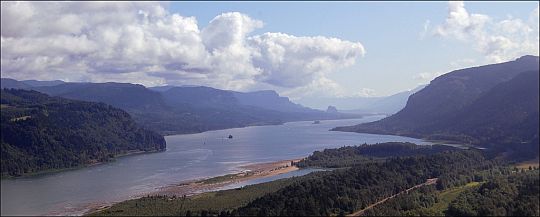As the Columbia River runs its 1,200-mile course from a Canadian glacier out to the Pacific Ocean, it passes by one nuclear production complex, 13 pulp and paper mills, and countless agricultural areas, mines, and sewer outflows from major cities.
So perhaps it should be no surprise that the U.S. EPA recently found that the river — which drains a 259,000-square-mile basin covering seven U.S. states and part of Canada — is carrying "unacceptable" levels of contaminants like mercury, DDT, PCBs, and PBDEs.
Although other river systems like the Mississippi and the Colorado contain comparable levels of DDT, PCBs, and mercury, an EPA official said that reducing pollution in the Columbia basin would be a high priority. This is good news for many Northwest tribes who rely heavily on Columbia River fish for their diet. It’s also important news for the region’s salmon populations, which use the Columbia and its tributaries as spawning ground.
So how did these contaminants end up in the river? Here’s a rundown, courtesy The Oregonian:
Mercury
Status: May be on the rise. Levels increased in osprey eggs in the lower Columbia River and in northern pikeminnow in the Willamette River in the past decade. Responsible for most fish consumption warnings in the Columbia basin.
Sources: Most comes from outside the area. Local sources include PGE’s Boardman coal plant and a cement plant near Baker City.
Concern: Can cause neurological and reproductive problems in people and animals.DDT
Status: Pesticide banned in 1992. Levels decreasing but still found at unhealthful levels in fish throughout the basin.
Sources: Mainly runoff from agricultural lands.
Concern: Thins bird eggshells, causes reproductive and development problems. Linked to cancer and other problems in laboratory test animals.PCBs
Status: Levels of the widely used industrial chemical banned in 1976 are also declining but still widely found in fish tissue and sediments.
Sources: Industrial spills and storm water runoff from industrial sites. Also airborne from distant sources.
Concern: Can harm hormonal, immune and reproductive systems in people and aquatic life and increase cancer risk.PBDEs
Status: Flame retardants present in many consumer products. Recently banned, at least partially, in both Oregon and Washington. Data is limited, but they appear to be increasing in fish.
Sources: Still uncertain, but several studies indicate municipal sewage wastewater may be a significant source.
Concern: Harm to mammals’ reproduction, development and neurological systems.



